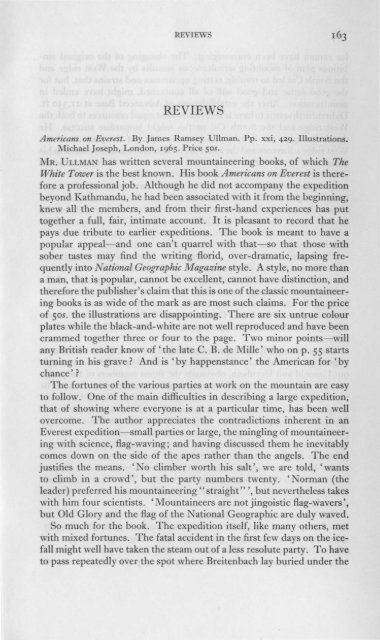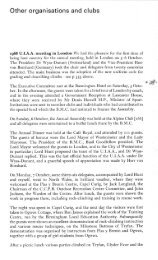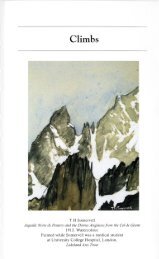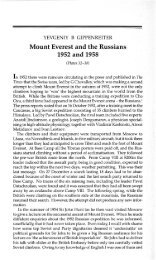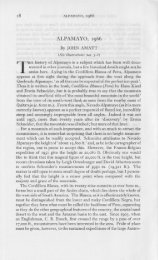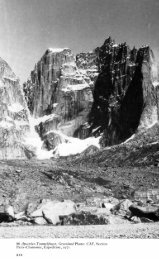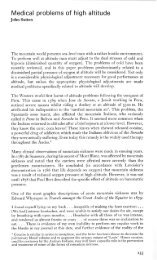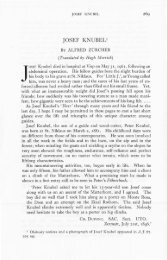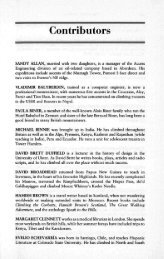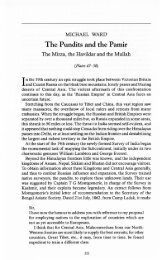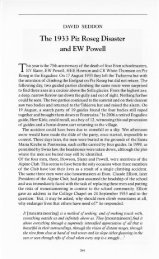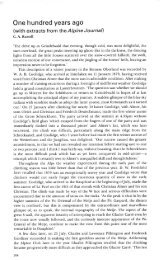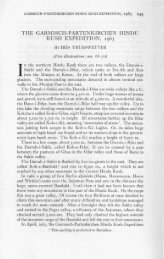AJ 1966 163-184 Reviews.pdf - Alpine Journal
AJ 1966 163-184 Reviews.pdf - Alpine Journal
AJ 1966 163-184 Reviews.pdf - Alpine Journal
You also want an ePaper? Increase the reach of your titles
YUMPU automatically turns print PDFs into web optimized ePapers that Google loves.
REVIEWS<br />
REVIEWS<br />
Arnericans on Everest. By James Ramsey Ullman. Pp. xxi, 429. Illustrations.<br />
Michael Joseph, London, 1965. Price sos.<br />
IVIR. ULLMAN has \vritten several mountaineering books, of which The<br />
White Tower is the best known. His book Americans on Everest is therefore<br />
a professional job. Although he did not accompany the expedition<br />
beyond Kathmandu, he had been associated \vith it from the beginning,<br />
kne\v all the members, and from their first-hand experiences has put<br />
together a full, fair, intimate account. It is pleasant to record that he<br />
pays due tribute to earlier expeditions. The book is meant to have a<br />
popular appeal<br />
and one can't quarrel with that so that those \vith<br />
sober tastes may find the \vriting florid, over-dramatic, lapsing frequently<br />
into National Geographic Magazine style. A style, no more than<br />
a man, that is popular, cannot be excellent, cannot have distinction, and<br />
therefore the publisher's claim that this is one of the classic mountaineering<br />
books is as wide of the mark as are most such claims. For the price<br />
of sos. the illustrations are disappointing. There are six untrue colour<br />
plates \vhile the black-and-,vhite are not well reproduced and have been<br />
crammed together three or four to the page. Two minor points<br />
\Vill<br />
any British reader kno\v of' the late C. B. de Mille' who on p. 55 starts<br />
turning in his grave ? And is 'by happenstance' the American for 'by<br />
chance'?<br />
The fortunes of the various parties at work on the mountain are easy<br />
to follow. One of the main difficulties in describing a large expedition,<br />
that of showing where everyone is at a particular time, has been well<br />
overcome. The author appreciates the contradictions inherent in an<br />
Everest expedition small parties or large, the mingling of mountaineering<br />
\vith science, flag-waving; and having discussed them he inevitably<br />
comes down on the side of the apes rather than the angels. The end<br />
justifies the means. 'No climber \Vorth his salt', \Ve are told, '\Vants<br />
to climb in a crowd', but the party numbers t\venty. 'Norman (the<br />
leader) preferred his mountaineering ''straight'' ', but nevertheless takes<br />
with him four scientists. 'Mountaineers are not jingoistic flag-wavers',<br />
but Old Glory and the flag of the National Geographic are duly waved.<br />
So much for the book. The expedition itself, like many others, met<br />
with mixed fortunes. The fatal accident in the first few days on the icefall<br />
might well have taken the steam out of a less resolute party. To have<br />
to pass repeatedly over the spot where Breitenbach lay buried under the<br />
•
REVIEWS<br />
ice cannot have been encouraging. The changing of the original ambitious<br />
plan of mounting simultaneous assaults by the \Vest ridge and<br />
the South Col led to trouble, setting up stresses and strains that, but for<br />
the good sense and good \vill of all concerned, might have ended in<br />
disintegration. Mter the establishment of Advanced Base at 21,350 ft.<br />
Dyhrenfurth seems to have feared that to allot equal resources to both the<br />
West ridge and the South Col parties might jeopardise success. He<br />
decided to give the latter priority and in spite of the protests of the<br />
West ridge adherents and the bitter arguments that ensued he stuck to his<br />
decision, a decision that was probably right and in the circumstances<br />
almost inevitable. Had it been a private expedition, ans\verable to no<br />
one, success would have been of less moment and both assaults might<br />
have been given equal chances. In \Vhich case it is conceivable that the<br />
West ridge party might not only have succeeded, as they did, but by<br />
having enough Sherpas to establish a camp higher than 27,250 ft. from<br />
which to start, might have been spared the night out at 28,ooo ft. on the<br />
South ridge with its unhappy consequences of frostbite.<br />
The reasons for the ten days of inaction at Advanced Base (21,350 ft.),<br />
while the unescorted Sherpas carried to the South Col, are not made<br />
clear. This seems to be carrying to an extreme the principle of the<br />
conservation of energy and cannot have been good for the morale.<br />
Judging by the account, long before the ten days \vere up, 'cafard'<br />
was oozing out of the tents. Our member J. 0. M. Roberts, in an entertaining<br />
note about the transport problems, also remarks on this long<br />
pause.<br />
The author rightly and repeatedly stresses the work of the \Vhole team<br />
in getting men to the top. Nevertheless it is hardly possible not to single<br />
out Unsoeld and Hornbein, obviously the fittest members of the party,<br />
the moving spirits on the West ridge, who from the start chose to be<br />
beaten if necessary by that, rather than succeed by the South Col route.<br />
In spite of having to make do with the scrapings of the barrel in the way of<br />
Sherpas and support parties, they stuck to their resolution through<br />
thick and thin and brought it to a triumphant conclusion. It needed<br />
audacity to persevere by their route and even more audacity '~rhen at a<br />
point 8oo ft. below the summit at three in the afternoon, with no sure<br />
retreat by the \vay they had come, they decided to push on and descend<br />
by what was to them the unknown South ridge. This \Vest ridge climb<br />
lifts the expedition to a high plane, a plane level with that of the first<br />
ascent of the mountain in 1953.<br />
No Everest book is complete without appendices. Here we have the<br />
lot finance, food, equipment, transport, health, oxygen, photography,<br />
communications, geology, glaciology, physiology, psychology, and<br />
(God save us) sociology. The tents are highly praised, yet at Camp 4W,<br />
'a broad level platform of snow, and idyllic camp site', three tents, one
REVIEWS<br />
with four men inside, were blown fifty yards down the mountain. The<br />
butane stoves, too, are given full marks in spite of an explosion at Camp<br />
VI which nearly put paid to the second summit party's effort.<br />
That science is madness, if good sense does not cure it, is surely plain<br />
when psychologists and sociologists are found accompanying a mountaineering<br />
party. Physiologists have been there before. In this case Dr.<br />
Siri, after several pages of mumbo-jumbo, arrives at two conclusions,<br />
neither of them new that high on Everest a man has no appetite and<br />
consequently is half-starved, and that fresh food is more palatable than<br />
processed food. In America, where they invented processed food, the<br />
latter may well be news. Dr. Siri remarks that' No one would argue that<br />
without oxygen life at 29,ooo ft. could be anything but short'. How<br />
short is short? Ten days, a week, a day, or a couple of hours? This<br />
reviewer likes to think that one day Everest will be climbed by a small party<br />
of really tough men without oxygen. Were it not that for centuries past<br />
they have been addicted to going about in hordes, and still do, the<br />
Russians or the Chinese would be the best bet. Perhaps a party of<br />
Sherpas would succeed. Before they caught the oxygen habit from their<br />
employers these men could carry 30 lb.loads to over 27,ooo ft. Carrying<br />
nothing they might well get unaided to the summit.<br />
On the whole this expedition is better to read about than to have taken<br />
part in. How many members of the <strong>Alpine</strong> Club would consent as these<br />
Americans did to a session at the Institute of Personality Research<br />
(IPAR), and how many would emerge from it unbroken in mind or<br />
body ? A party of twenty climbers, 900 porters, costing 4o,ooo odd<br />
quid! Having faithfully perused the book to the last appendix your<br />
reviewer's thoughts turned reluctantly but sympathetically towards<br />
Maurice Wilson. He may have been mad, or as our sociologists put it,<br />
'not fully in touch with reality', but at any rate he had in him the root<br />
of the matter. And if he was mad he had probably been reading too many<br />
Everest books.<br />
H. W. TILMAN.<br />
Bataille pour leJannu. By Jean Franco et Lionel Terray. Pp. 293. Illustrations.<br />
Editions Gallimard. 1965. Price Frs. Ig.so.<br />
IN an interesting preface, Lucien Devies justifies a claim that in the<br />
mountaineering achievements of the last few years, the part played by<br />
France has been 'capitale '. In the Himalaya, as in the Alps many years<br />
ago, difficulty has begun to replace novelty in the choice of peaks to<br />
stimulate the supreme efforts of ambitious climbers. And for difficulty<br />
Jannu was a good choice, as any reader of this book will agree. Its<br />
conquest is fairly claimed to be the most difficult and the boldest feat<br />
accomplished up to date in the Himalaya. For Tenzing, one of the first<br />
two on the top of Everest, J annu is 'a fierce giant, who sits on his throne
166 REVIEWS<br />
overlooking the Nepalese valleys, especially the Y amatari; its other<br />
slopes are so steep and high that he has nothing to fear; when men or<br />
yeti appear, J annu just puffs and everything disappears'. And that is<br />
what very nearly happened on the first attempt.<br />
We are given a gay picture of a very festive evening at the Planters<br />
Club at Darjeeling in 1955, at which French and English climbers met<br />
after wonderful successes on Makalu and Kangchenjunga. Jean Bouvier<br />
and J oe Brown exchange reminiscences of final passages, while Pierre<br />
Leroux and George Band do likewise by means of friendly pats on the<br />
back. Mrs. Dewer, 'blonde et parfumee, decouvrait 1' Himalaya';<br />
and the attack on J annu was born.<br />
The attempt of 1959 was hampered by bad weather and many days'<br />
delay by the Bengal customs office; but, as the photographs show, the<br />
approach from north and east offers no prospect of success. A fire where<br />
the elaborate equipment of the expedition was stored in France added<br />
to the worries of the party, but early in March the exasperating demands<br />
of the Indian customs authorities w.ere satisfied, porters were engaged,<br />
Nepal was entered, and a long column of 320 moved up towards the<br />
battlefield. Pictures of the pagoda at N yapotala and of the monastery<br />
at Khunza give some idea of the variety of human existence met with in<br />
this country.<br />
Nearly all were experienced climbers over thirty, including five who<br />
had ascended Makalu. The dangerous nature of Jannu was shown when<br />
an enormous avalanche fell over the route on which it was feared that<br />
several of the party were engaged. Luckily, they were not on it ~hat day<br />
and the route shown on pages 94 and 290 was abandoned. A very fine<br />
piece of leading on the new route was done by Jean Bouvier; no cracks<br />
in rock for pitons, and ice so steep that there was at times no room for<br />
the oxygen mask between the climber's nose and the slope. Even<br />
Terray and the two with him were 'ebahis'. The arete was gained at<br />
about 7,300 m.; progress had been continuously difficult ice-axe in one<br />
hand, an ice-piton held like a dagger in the other, with oxygen tube<br />
rubbing against the slope, some security gained by the rope around<br />
an axe hammered in every 100 ft. Late that evening the four men<br />
returned to Camp V exhausted and defeated. Franco, thinking Paragot<br />
might have a better chance next day than himself, suggested that he<br />
should accompany Magnone. He refused: 'Non, Jeannot ... le Jannu<br />
c' est toi'. The three huddled into a small tent for the night. A blinding<br />
pain in the eyes put Franco out of action in the morning. He waited<br />
anxiously till evening. He was woken by voices close to the tent: 'Allo<br />
Jeannot? Ton Jannu, c'est une vacherie.' That was the end of the<br />
attempt. Rightly, it was decided that the risk of a tragedy, if an attempt<br />
was made on the morrow, was too great. The party came down leaving<br />
some z,ooo m. of rope and 150 pitons to· vanish under the ice.
REVIE\VS<br />
The tale of I 962 is told by Lionel Terray; it is very good reading and<br />
there is little that is repetitive. Six of the 1959 party \vere there, four<br />
others replacing Franco and Magnone. One of them combined the<br />
professions of mountain guide and Protestant pastor; the youngest,<br />
aged t\venty-eight, \Vas the only complete amateur, \Vith no experience<br />
of mountains higher than the Pyrenees, but amply endo\ved \Vith the<br />
qualities needed for a strenuous expedition. 1.,erray himself \\·as not too<br />
fit at the start. He had not really recovered from a bad fall when he<br />
broke several ribs; he \Vas exhausted by over\vork, had got rather fat,<br />
slept badly: for him the getting into training \\as a 'veritable calvaire,.<br />
What he accomplished is all the more wonderful.<br />
The picture of the ice-fall bet\veen Camps V and VI gives some idea<br />
of the continuous difficulties. As Terray says: the systematic use of fixed<br />
ropes has been the key to open up a new field of action in the conquest of<br />
the Himalaya. All the ropes and pitons of the I 959 attempt had vanished.<br />
Sherpas did a fine bit of \\·ork carrying up tree trunks to bridge a chasm<br />
on the \vay up to Camp Ill. The battle to reach Camps \T and \ ;I is<br />
illustrated by pictures that are a tribute to the vvielders of the cameras.<br />
The description of the final 300 m. is a worthy ending to the tale.<br />
Three Frenchmen and one Sherpa fight their \Vay to the top in intense<br />
cold and get back exhausted to Camp VI. Next day, Terray with the<br />
remaining three Frenchmen and the Sherpa V\' ongli also reach the top,<br />
W ongli carrying a 5 kgr. cylinder of oxygen which he disdains to use.<br />
Terray pays generous tribute to the team-work which alone made<br />
possible the establishment of a satisfactory sleeping tent at VI and the<br />
equipping of the innumerable difficult passages with ropes and pitons.<br />
It is an exciting story: a battle inspired by the challenge of novelty<br />
and difficulty that was taken up over a hundred years ago. Greater<br />
facility of access and more elaborate equipment may tend in time to<br />
diminish the strength of this challenge. Fortunately, the appeal of<br />
mountains remains, what they are and what they suggest to us in our<br />
quiet moments among them. The call to climb \vill ahvays be there to<br />
listen to and to obey.<br />
R. L. G. IRVING.<br />
Mountaineering. By Alan Blackshaw. Pp. 542. 172 illustrations and line drawings,<br />
4 maps. Penguin Books. 1965. Price 18s. 6d.<br />
I HAVE just enjoyed a February mountaineering holiday, the theoretical<br />
part of which consisted of reading Alan Blacksha\v' s book and recalling<br />
the pleasures of sun-baked rock. The practical side was limited to<br />
solitary hill-walking in wind and rain; which underlined the necessity<br />
for his warnings about conditions. 1\lountaineering is instructive, \vhich<br />
it is meant to be, and interesting \vithout pretending to be anything but<br />
a textbook. Surprisingly, its predecessor, Barford's Clirnbing in Britain,
168 REVIEWS<br />
was published twenty years ago, and now seems rather antique. Compared,<br />
the two give an insight into recent climbing history, but it is a pity<br />
that the I 946 price of one shilling is so much increased. Neither book<br />
sets out to lure the non-climber to the hills, but the present volume is<br />
more attractive to the 'browser' and the general mountain views will<br />
tempt him to buy, even if the stark technical detail appals. Thus yet<br />
more feet may be set on the mountain trail, safely if our mythical novice<br />
(are there any these days ?) heeds its contents.<br />
This is not to suggest that he will be able to rush off and do, say, the<br />
nearest V.S., but realistically he is urged to begin by scrambling and hillwalking.<br />
Often omitted in this 'whizz-kid' age, this basis ensures a<br />
continuing interest in hills even after the youthful ability in exciting rock<br />
climbing wanes. Equipment, planning and organisation are covered,<br />
and there are clear sections on route-finding and weather hazards.<br />
Logically enough, the course ignores rock climbing at this stage, and<br />
introduces the initial techniques of snow and ice mountaineering as<br />
needed in winter hill-walking, and there is valuable advice on avoiding<br />
the effects of exposure.<br />
At this point equipment is reviewed in detail, with sufficient discussion<br />
of the merits of alternatives to enable a good choice to be made from the<br />
surfeit available in Britain's climbing-shops. Many modern climbers<br />
are amazed that nails are mentioned at all. That they are, gives an indication<br />
of the thoroughness with which the author has fulfilled his task.<br />
However, as a one time clinker expert, I quarrel with the statement that<br />
they (in rock climbing) 'require a rather muscular technique'. The idea<br />
nevertheless has impeccable ancestry, being held by Colin Kirkus, and<br />
first appearing in print in Let's Go Climbing, the book which did most to<br />
persuade me to do so.<br />
Part I ends with a section on living in the British mountains which<br />
fairly assumes some general camping knowledge. The differences<br />
between camping at an organised site or in a sheltered valley field and in<br />
exposed and rigorous positions are well brought out, as is the need for<br />
specially designed equipment which is both strong and light. It is<br />
recommended here that paraffin or petrol should be kept in polythene<br />
containers, but these liquids will swell, weaken and discolour the polythene<br />
from which cheap bottles are made. The more rigid types should<br />
be sought or, better still, nylon should be used, as it is unaffected by<br />
hydrocarbons.<br />
The potted history of rock climbing is not really adequate. The<br />
omission of the names of some of the great innovators before 1930 is<br />
regrettable, and anyway Edwards was not a major participant in the<br />
exploration of' Cloggy' and the East Buttress of Scafell. His exceptional<br />
talents were exercised elsewhere, notably on Clogwyn y Geifr, the Llanberis<br />
cliffs and Lliwedd. Sensible comnients are made on guide-books,
REVIEWS<br />
personal (mental) approach and fitness, but it might also be added that<br />
weight training is valuable in winter or for those unlucky enough to live<br />
far from the outcrops which give northern climbers the advantage of<br />
evening practice.<br />
In general the detail of rock climbing technique is well illustrated and<br />
described, but one or two points need comment. First, the myth of the<br />
active participation of the fingers in hand-jamming, which is hardly<br />
ever necessary, is perpetuated. It is, in fact, far more efficient and<br />
restful to rely on the inwardly rotated thumb. This provides an excellent<br />
friction grip in the crack between the back of the hand and the ball of the<br />
thumb, and allows the fingers to remain relaxed. Next, the 'jamming<br />
alone' and 'lay back' sequences can be criticised. For the former a<br />
steeper crack in a blank face would make the point much more strongly<br />
that a smooth crack can be climbed without external holds. Similarly,<br />
a much more extreme lay back position could have been chosen to demonstrate<br />
the technique. A very good point is the inclusion of elementary and<br />
advanced methods together, as the sooner all the skills are understood the<br />
better. Advanced techniques are useful on even the easiest of climbs.<br />
The greatest contrast between the Barford and Blackshaw texts js that<br />
at the end of the \Var Barford refers to nylon as having shown virtue in<br />
the Services. Now, as he forecast, safe climbing is based on the use of<br />
such ropes, with manila and Italian hemp relegated to auxiliary tasks<br />
such as waist loops and abseil slings. Since I 946 protection techniques<br />
with nylon slings on natural running belays have been developed, and<br />
now the dubiously ethical device of a jammed nut (even if used for direct<br />
aid inexplicably regarded as more sporting than a peg) is described. One<br />
cannot learn from a book all the tricks and subterfuges possible to protect<br />
a lead, but at least the ideas are here to use as a base for experience. On<br />
hard climbs, the ration of three to six slings seems rather meagre when<br />
many leaders carry ten or twelve. Advice on the size of rope to use for<br />
slings is sound, and the comments on wire slings are fair. The alternative<br />
of nylon tape slings (made from seat belt harness and capable of use on<br />
smaller spikes) is not mentioned, although, later, tape etriers are introduced.<br />
It cannot be too strongly urged that a leader should study carefully<br />
the advice on the correct use of karabiners given in this section and<br />
the next, as this aspect of safety tends often to be missed.<br />
Artificial climbing techniques are explained and demonstrated in<br />
photographic sequences, but I think line drawings would have been<br />
clearer. (This applies also to the rock technique photographs, where<br />
chimney climbing methods are shown by an admirable sketch.) The<br />
easy part of artificial climbing is to understand the process. It is far more<br />
difficult to apply it, and yet more difficult to apply it economically, i.e. by<br />
using pegs planted only sufficiently well to enable progress to be made.<br />
Thus the technical dissertation about the positioning and insertion of
170 REVIEWS<br />
pitons is very valuable, but of course experience is essential to develop<br />
the necessary judgement to use the methods quickly and safely.<br />
Equipment for snow and ice climbing is detailed, starting off with a<br />
question, crampons or nails ? The points for and against are well made,<br />
although perhaps more stress should have been laid on the merits of<br />
lobster-claw crampons for hard winter climbing in Scotland, such as on<br />
Ben Nevis. The difficulty of placing ice-pegs and screws firmly in<br />
British water-ice is brought out, and the corollary added that rock or<br />
rock piton belays are to be preferred where it is possible to find<br />
them.<br />
The British section is concluded on a serious note about accidents.<br />
The analysed statistics give food for thought, and the concise account of<br />
rescue arrangements should improve the speed with which help can be<br />
summoned by people who have read this far. Specialised equipment at<br />
the rescue posts is detailed, although a list of the contents of the two<br />
standard rucksacks is not. No one surviving an accident will be in doubt<br />
what to do,_ nor indeed are they so likely to be involved if they have<br />
digested all that has gone before.<br />
<strong>Alpine</strong> mountaineering, covered in Part III, is in many ways the best<br />
part of the book. The different approach of the British climber from that<br />
of the born and bred continental is hinted at, and emphasis is laid on the<br />
necessity to move quickly and safely on relatively easy but dangerous<br />
ground. This is the biggest single difference, apart from environment,<br />
between the Alps and the homeland, and even good British teams are<br />
often lamentably slow and clumsy on typically shelving ledges covered<br />
with scree and snow. There is tremendous pleasure to be gained in<br />
competent negotiation of this type of ground on general mountains (as<br />
opposed to those predominantly of rock, snow or ice).<br />
Whether to take a guide or not is an academic question for many<br />
impecunious young climbers, but it is true that much more can be<br />
achieved in a limited time if one is employed. Local knowledge of<br />
routes, weather and conditions means that a party can set off confidently,<br />
rather than be tortured by indecision and waste time sitting in valleys or<br />
huts watching cloud break up and weather improve, just as it becomes too<br />
late to do anything!<br />
Glacier travel, the only specifically alpine skill necessary, and its<br />
principles are related to British experience, and the big variations in<br />
snow and ice conditions throughout a day are emphasised. Route-finding<br />
on rock is probably not so easily teachable, but a knowledge of mountain<br />
structure based on reconnaissance is useful, as Whymper found when he<br />
realised the easy angle of the Hornli ridge seen in profile. Rightly,<br />
descent is dwelt upon, either by climbing or by abseil, and a warning<br />
given that this is the phase of the climb when most accidents occur.<br />
Various crevasse rescue techniques are explained, with a conscious effort
REVIE\VS<br />
to point out the great difficulties involved and the desirability of not<br />
having to apply them. Particularly it is necessary for parties to establish<br />
the procedure they will adopt before the accident occura.<br />
I have left comment on the sections describing where to climb in<br />
Britain and the Alps to the end, as these can be regarded as appendices.<br />
They are both comprehensive and include details of guide-books and<br />
other sources of information about each area. Although they are short,<br />
there are no notable omissions, and the comments about each area are<br />
sufficient to indicate what will be found. The true appendices are<br />
excellent. They include the full address of almost every organisation (if<br />
not all) a mountaineer could conceivably need. Map-reading and knots<br />
might perhaps have found a place in the main text; the selected bibliography<br />
is well arranged and reasonably complete. The glossary of Gaelic,<br />
Norse and Welsh words is interesting, but why not include French,<br />
German and Italian as well, if it is regarded as essential!<br />
To summarise, this is an excellent textbook, distilling tastefully a wide<br />
experience, gained over nearly twenty years, into an essence of safe<br />
mountaineering. It is rather heavy to take at one sitting, but will prove<br />
invaluable to the novice and good average climber alike. Indeed, it will<br />
benefit even the expert to have the reasons and practices of his sport<br />
analysed as well as this.<br />
A. J. J. MOULAM.<br />
Il Monte Bianco: dalle esplorazioni alia conquista (ro9I-1786). Antologia di<br />
Alfonso Bernardi. Bologna: Zanichelli, I 965. 317 pages, profusely<br />
illustrated, some plates in colour. Price L. s,8oo.<br />
IN spite of its title, this book is not what would be called an anthology<br />
or collection of published texts, for many of the chapters appear to have<br />
been written expressly for it. The editor is well aware of the facts<br />
regarding Balmat's greed, Bourrit's malice, and Saussure's betrayal of<br />
the truth, and he stigmatises the Balmat legend as c questo falso storico '.<br />
He ends the argument by giving a transcription (all documents are<br />
transcribed into Italian) of Balmat's sworn affidavit that Dr. Paccard<br />
arrived at the summit first and that he had paid Balmat for his services.<br />
While this is all correct, it does not cover the whole of the evidence which<br />
proves conclusively that Dr. Paccard was the victim of injustice and of a<br />
conspiracy of silence. Nevertheless, Signor Bernardi's presentation of<br />
the case is unexceptionable as far as it goes. But what is one to make of<br />
the foreword by Signor Giuseppe Mazzotti, who accepts the fraudulent<br />
story of Balmat' s four nights on the mountain, lock, stock, and barrel ?<br />
It is astonishing that such an exploded myth should continue to have<br />
any credit, and should be included in a preface to a book which reflects<br />
the conclusions of all objective research on this question. Indeed,
172 REVIEWS<br />
Signor Mazzotti makes matters worse when he asks, rhetorically, what<br />
does it matter who arrived ten or twenty paces in front of or behind<br />
the other ? Did the doctor help Balmat ? 'La cosa e poco credibile'<br />
[=difficult to believe]. Did Balmat encourage and help the doctor?<br />
'Questo sareb be nell' or dine naturale delle cose' [ =this would be in<br />
the normal order of things]. If this is the way in which history is to be<br />
treated and vulgarised in forewords to popular books, there is little<br />
hope of maintaining any standards of accuracy, reliability, or even<br />
intellectual integrity at all.<br />
A word should be said about the illustrations. Many of the textfigures<br />
reproduce sketches drawn in 1807 by Henri-Albert Gosse and<br />
showing Dr. Paccard (two sketches), the Cure of Chamonix, Marguerite<br />
Bochat, Jean-Fran9ois Balmat, Joseph Tournier, Pierre Balmat, Jean<br />
Marie Carrier, and J acques Balmat' s house. These are of such great<br />
interest and novelty that it would reasonably be expected that their<br />
provenance should be indicated in the legend to each sketch. Not a<br />
word is given of their provenance, and the reader is left to surmise that<br />
they come from the Archives H-A. Gosse in the Bibliotheque publique<br />
et universitaire de Geneve, mentioned in the Bibliography without<br />
indication of what use has been made of them. Another puzzle relates<br />
to the reproduction of the fine oil portrait of Dr. Paccard, facing page<br />
240. Of this the legend says that it was published for the first time by<br />
C. E. Mathews in The Annals of Mont Blanc in 18g8, when it belonged<br />
to J. P. Cachat. It was clearly not from that source that the portrait in<br />
the present book was reproduced, and it would be interesting to know<br />
not only to whom the original now belongs and who supplied the<br />
photograph, but also why this information has not been given.<br />
The colour plates are poor; there is no list of illustrations.<br />
One final point of scholarship. Signor Bernardi says, referring to the<br />
twenty-four words on the first ascent of Mont Blanc in Dr. Paccard's<br />
Notebook (on p. 283), that this is all that the doctor left in writing<br />
about his great achievement. 'E null' altro per tutto il resto de la sua<br />
longa vita' [and nothing more during the whole of his long life]. Is<br />
Signor Bernardi really ignorant of the document, 'Observations sur le<br />
Mont Blanc', with a tracing of the level of mercury in his barometer<br />
throughout his ascent and indications of the places where he made his<br />
readings, and Baron von Gersdorf's thermometer readings at Chamonix,<br />
written immediately after the ascent, and of Dr. Paccard's letters to the<br />
editor of the <strong>Journal</strong> de Savoie, published in 1823 and 1825? All this<br />
information is available in The First Ascent of Mont Blanc, which was<br />
published in 1957 on the occasion of the centenary of the <strong>Alpine</strong> Club,<br />
and an edition of this book, translated into Italian, was published in<br />
Milan in 1960.<br />
•<br />
GAVIN DE BEER •
REVIEWS<br />
Mont Blanc; an Anthology. By Claire Eliane Engel. Pp. 232, 69 plates. George<br />
Allen & Unwin, Ltd. London. 1965. Price 54s.<br />
THERE could certainly be few more suitable compilers of a Mont Blanc<br />
anthology than Mile. Engel, who has for many years graced Les Praz for<br />
long periods annually, knows everyone worth knowing in the Chamonix<br />
valley, has climbed extensively in the massif in the company of such<br />
famous climbers as Gaston Rebuffat, and has surely read or heard every<br />
story, from the factual to the wildly fictional, which the mountain has<br />
evoked. Moreover, alpine knowledge apart, her wider historical and<br />
literary researches into the lives of every character she quotes, great or<br />
obscure, who has ever come to worship the mountain from its comfortable<br />
feet, or to grapple less comfortably with its snowy slopes and the granite<br />
of its satellites, render her specially well equipped for the task.<br />
Here then, as we might expect, are the familiar, as well as many newer,<br />
pieces from the early days, before and soon after the first ascent; exciting<br />
passages from the accounts of recent sensational climbs in the group,<br />
some not previously published; a hair-raising glimpse of modern<br />
warfare on the rocks of the aiguilles ; accidents and disasters, factual and<br />
fictional, ancient and modern, though, disappointingly, nothing from<br />
the reports of the most notorious of the latter, involving helicopter rescue<br />
attempts and much controversy. Here, too, are the few poems which in<br />
any way measure up to their subject, though it is something of a shock<br />
to learn, thanks to the compiler's erudition, that Coleridge never so much<br />
as saw the Alps, and his much-admired 'Hymn before sunrise in the<br />
Vale of Chamonix' is simply a skilful adaptation of a poem by an obscure<br />
Danish poetess.<br />
It seems a pity that this attractive book should be marred, particularly<br />
in the biographical notes at its end, by a considerable number of misprints<br />
and, in places, by inaccuracies of fact, some of which are dealt with in<br />
an editorial footnote to this review. 1 These can no doubt be eliminated<br />
and corrected in any future edition.<br />
In all, the book provides a comprehensive and entertaining collection<br />
of the things written about, in praise of, and in antipathy to Chamonix's<br />
great mountain complex, at all levels, alpine and literary. It is well<br />
produced, pleasant to handle, and illustrated mainly by excellent<br />
reproductions of old sketches, engravings and paintings, which may<br />
account for the somewhat high price of publication. There are also a<br />
number of photographs, a few of them superb, others rather less so.<br />
HUGH MERRICK.<br />
1<br />
Editorial note: A book of this nature, though not history in the strict sense,<br />
nevertheless takes on a historical character as it ranges over the years during<br />
which Mont Blanc is studied. It therefore is necessary to try and keep it accurate,<br />
and more care should have been expended. Space here prevents our recording<br />
more than a portion of the slips noticed.
174 REVIEWS<br />
Page I3. The first ascent of Mont Aiguille is, apparently, classed with Noah's<br />
ascent of Mount Ararat as something to discard, as though a myth. There seem<br />
to be no grounds for doubting the ascent; see Monroe Thorington in A.A.J.,<br />
I965, p. 359· A name given on this page should be Rene le Pays.<br />
Page I 3, n. I. Two books of J. J. Scheuchzer have been confused; the date<br />
of one with the title of the other.<br />
Page 23, n. I. It was in I754, not 1753, that J-A. de Luc and his brother<br />
went to Chamonix, when Rousseau himself was in Geneva. There is no record<br />
in Rousseau's Correspondance Generale of any letter from them in the earlier<br />
year.<br />
Page 49, n. 2. When Dickens refers to 'Georgey', he is speaking, not of<br />
his son (he had none named George), but of his sister-in-law, Georgina Hogarth.<br />
See p. 225 also.<br />
Pages 74-6. No source is quoted for the long extract from Rebuffat's writings.<br />
Pages 99- IOO. The transcription of the text as printed by Francis Birrell is<br />
very imperfect; words inserted, words omitted, spelling and punctuation<br />
modernised.<br />
Pages 10o-1. For this anonymous account of the first ascent of Mont Blanc,<br />
see de Beer's article in A.J. 67. 233-4. The date quoted on p. IOI should be<br />
September r 8, not I 5, and the footnote on the same page is very much open to<br />
doubt-vide de Beer's comments.<br />
Page I77, plate 62. This is the East, not the South face of Mont Blanc.<br />
Page 193, n. 2. Les Delices de la Suisse, Leide, 1714, published under the<br />
pseudonym G. Kypseler de Mi.inster, was by Abraham Ruchat. A different<br />
book, L' Etat et les Delices de la Suisse, Amsterdam, I730 (many subsequent<br />
editions at Basle, Neuchatel, Paris) was a compilation made by J . G . Altmann,<br />
J. R. Tillier and others, out of Ruchat's book and Abraham Stanyan's An Account<br />
of Switzerland, London, I 7 I 4· This last book was published in French translation<br />
(made by Sir ? Luke Schaub) under the title L' Etat de la Suisse, ecrit en<br />
I7I4. Traduit de l'Anglois, Amsterdam, 1714. The present footnote ascribes<br />
one of these books to the wrong author.<br />
Pages 223-32. These notes should be very carefully revised, for errors abound.<br />
Thus, Adelbert: Aldebert (pp. viii unnumbered; 19, 85, 223); C. E. Mathews<br />
is apt (cf. pp. 18, 223, 228) to get his name misspelt and his initials wrongly<br />
given; Wallroth, Bonatti, and Desnoues (cf. p. 193) are also liable to error. Under<br />
'Almer', correct Sesiajosh; Jakob Anderegg did not make the first ascent of the<br />
Aiguille V erte, and his employer was not Morsehead. Melchior Anderegg was<br />
born 1827 and died 1914. Was Jacques Balmat born in 1764? Hermann Buhl<br />
was an Austrian, not a German; Alexander Burgener made the first descent, not<br />
ascent, of the Mittellegi ridge (which last is misspelt); Goethe went not three,<br />
but four times to Switzerland 1775, 1779, 1788, 1797; Sir William Hamilton's<br />
dates are I730-I803, not I738-r8o6; the Duke of Hamilton mentioned was the<br />
8th, not the 7th; A. E. W. Mason's date of death is given as I848, and Mummery's<br />
date of birth as r856. Horace Walker died in 1908 and Sir Alfred Wills in 1912;<br />
Wordsworth's visits to the Alps were in 1790 and 182o, not 1792 and 1822.<br />
Some of the books credited to authors could do with a little revision as to<br />
titles; Bourrit has three titles misspelt and Buhl one. The titles of Kugy's books<br />
also need rechecking, as does Noyce's book on Machapuchare. Winthrop<br />
Young's well-known work was Mountains (not 'Climbing') with a Difference.<br />
In a work drawn from so many sources, it is easy for misprints to occur, hence<br />
the more need for meticulous accuracy in checking with the originals. Offhand,<br />
pages where extracts might usefully be rechecked are 112, 122, 151, 158, I6I and<br />
•<br />
210.
REVIEWS 175<br />
liistory of the S£erra Nevada. By Francis P. Farquhar. Pp. xiv, 262. Illustrations,<br />
maps. University of California Press, Berkeley, Calif. 1965. ~Io.oo.<br />
BY THE nature of things the superb Sierra Nevada mountains in California,<br />
almost as far from South Audley Street as a mountain range can<br />
be, have always been an American preserve. They stand between the<br />
deserts of Nevada and the lush Central V alley of California, where the<br />
oranges grow, and it is really their presence, a generous watershed and a<br />
rampart against east winds, that makes the 'Golden State' what it is.<br />
A back-handed testimonial, perhaps, but the respect the Americans<br />
have shown for this marvellous slab of country should be a lesson to us<br />
all. Mr. Francis Farquhar's handsome history of the range is sponsored<br />
by the Sierra Club, the oldest of California's mountain societies, and is<br />
in effect a record of that respect. The Americans realised from the start<br />
the significance of the Sierra Nevada, and in the 140-odd years since the<br />
mountains were first crossed by white men, they have carefully mastered<br />
and exploited the range, warily tapping its varied resources, and honourably<br />
capping it all with a dedicated campaign of nature conservation.<br />
It is a thoroughly American story, and Mr. F arquhar' s history must<br />
be read as an American book something specific, that is, within the<br />
comity of Anglo-American letters. In that genre it is wholly satisfying.<br />
It begins properly at the beginning, with the geographical meaning of<br />
the range, its fauna, flora and igneous rock. Then the Indians make their<br />
appearance, like the housemaid at the start of the first act, to be followed<br />
in a swift and easy succession of scenes by Spaniards, trappers, transcontinental<br />
immigrants, gold prospectors, soldiers, naturalists, roadbuilders,<br />
railwaymen, tourists, mountaineers and finally, in a happy last<br />
act, conservationists.<br />
All is told with a combination of guileless enthusiasm and painstaking<br />
scholarship that is very American. The colours are rich. It is true that<br />
Mr. Farquhar evades the macabre details of the Donner Pass catastrophe,<br />
when a party of immigrants was reduced to eating each other: but we do<br />
meet 'Snow-shoe' Thompson, that indomitable stalwart of the Sierra<br />
winters, we fight an Indian \var or two, we stop off with the prospectors<br />
at Yank's in Lake Valley, and we are present at the splendid moment when<br />
a hunter called A. T. Dowd first sets eyes on a Big Tree. The book is<br />
pleasantly illustrated with photographs and old prints, and complemented<br />
with clear maps by Nancy Foucet.<br />
There seems to be scarcely an inch of the range that Mr. Farquhar<br />
does not kno\v, and there is certainly hardly a pitch he and his wife have<br />
not climbed. His book will give pleasure not only to those deprived<br />
thousands who will never see the Sierra Nevada for themselves, but also,<br />
we may be sure, to the shade of old John l\1 uir, first President of the<br />
Sierra Club, \vho loved these mountains in just the same way, and \V hose<br />
noble aspiration it was to 'do something for wildness'.<br />
12
REVIEWS<br />
The Cambridge University Press will be publishing this book shortly<br />
in England.<br />
}AMES MORRIS.<br />
Alpes et N eige. IOI S ommets a Ski. By Philippe and Claude Traynard. Pp. 108;<br />
101 illustrations. B. Arthaud, Paris, 1965. Price not stated.<br />
THIS IS the type of book that ski-tourers, and especially ski-mountaineers,<br />
have been waiting for. Professor Philippe Traynard, President of the<br />
Isere section of the C.A.F., and his wife have classified in just the form<br />
which one would wish the fruits of twenty seasons of off-piste wandering<br />
and winter exploration. Their stated aim has been to inspire others to<br />
follow them into the winter solitude of the mountains, thereby gaining<br />
the desire and the confidence to add to their impressive list of traverses<br />
and ascents for the benefit of still others who come afresh.<br />
Three limitations should be noted at once. The text demands the<br />
same knowledge of French as would be needed for a summer guide-book<br />
in that language: the volume is both too weighty ( 2 lbs. exactly) and too<br />
fine a work of art to slip into the touring rucksack: and, lest <strong>Alpine</strong> enthusiasts<br />
should be disappointed in an eager search to see whether their<br />
favourite summer peaks have been included, it should be made clear<br />
that the Traynards' ski tracks do not lead outside France.<br />
The authors start with three pages of introduction, giving tips on maps<br />
and route-finding and explaining the assumptions upon which their<br />
classifications and timings rest. These assumptions appear eminently<br />
sensible, inclining always in the direction of prudence. Then follow one<br />
hundred and one single-page descriptions of routes, each faced by a fine<br />
full-page black and white photograph of the ski ground on the peak or<br />
pass in question. No doubt it would offend the purist, but dotted lines<br />
on some of the photographs indicating the approximate routes would<br />
have been an aid in following the text.<br />
The descriptions of the routes are logical and informative, starting<br />
with instructions for the motorist. Altitudes, vertical heights of ascent<br />
and descent, timings, references to map sheets, orientation of ski slopes<br />
and optimum months for the expeditions are set out in tabular form. The<br />
subjective factor is covered by grading the performers as 'skieurs<br />
moyens ', 'bons skieurs' and 'tres bons skieurs '. Little more is required<br />
of a member of the first category than that '(11) doit pouvoir evoluer sur<br />
des pentes modestes (2o 0 )<br />
en pla9ant son virage au lieu qu'il s'est propose',<br />
whereas 'le tres bon skieur n'a aucune probleme de technique et<br />
aborde les pentes tres raides et les couloirs etroits avec la certitude d'y<br />
trouver un reel plaisir '. Those who feel no such certainty but nevertheless<br />
attempt one of these routes should presumably venture late in the<br />
season to allow plenty of daylight and cl).oose long-suffering 'tres bons'<br />
companions. The addition of the word 'alp ins' to the classifications
REVIEWS 177<br />
indicates difficulty relating to the mountain itself and is generally reinforced<br />
by the recommendation that any or all of rope, axe and crampons<br />
are c utiles '' c necessaires' or c indispensables '.<br />
The text falls under the headings: Acces, Montee, Descente, Remarque.<br />
It is in straightforward guide-book style. On each page there<br />
is a scaled-down sketch-map as an aid to navigation, prefaced by a<br />
fearsome general injunction against leaving base without both 1 :zo,ooo<br />
map and aneroid. The areas covered will be unfamiliar to many so it is<br />
worth listing the groups in full: Faucigny-Aiguilles Rouges-1\iont<br />
Blanc, Aravis, Beaufortain, Tarentaise, V anoise, Maurienne, Chartreuse<br />
Belledonne-Vercors, Romanche, Oisans-la Berarde, Oisans-Brian
REVIEWS<br />
Nepal and the Gurkhas. Edited by Colonel R. G. Leonard. Pp. 158. Illustrations<br />
and map. H.M.S.O. for Ministry of Defence. 1965. Price 17s. 6d.<br />
THIS is a revised edition of a handbook intended primarily for the<br />
instruction of officers serving with Gurkha regiments. It is based<br />
largely on the edition of 1936 which was prepared by the present<br />
reviewer when he was a serving officer, but the book has been brought<br />
up to date in the light of the changes that have taken place since Nepal<br />
ceased to be a closed country. The anthropological information about<br />
the various tribes has been retained but Colonel Leonard has discarded<br />
the scientifi~<br />
method of transliterating N epali words which I felt was<br />
one of the most valuable features of my edition. The bibliography,<br />
which was complete when I compiled it, is now out of date and should<br />
have been revised. The sketch-map is of no practical use and one or<br />
two of the illustrations are tactful rather than illuminating.<br />
In his introduction the editor expresses the hope that this handbook<br />
will have a wide general circulation now that Nepal is open to tourists.<br />
In my opinion it is too specialised to be of much interest to the casual<br />
visitor since it lacks the sort of practical information he most needs<br />
about hotels, prices, and so on. There is no mention of mountaineering<br />
inN epal or of the method of obtaining permission to organise an expedition.<br />
Nevertheless the book is a useful introduction for all those who<br />
may expect to have dealings with the people of Nepal.<br />
JOHN MoRRIS.<br />
Cervino I 865/I965. Fotografia e testi di Mario Fantin. Pp. 155. Tamari Editori<br />
in Bologna. 1965. (No price.)<br />
Tms book on the Matterhorn, with a preface by Giuseppe Mazzotti,<br />
is but the latest to hand of numerous books produced in the centenary<br />
year; but it is, of its kind, one of the best. Primarily photographic,<br />
the letterpress is in four languages (Italian, French, English, German),<br />
and it depicts the mountain under various headings the beauty of the<br />
mountain; the climbers, dead and living; the routes followed; the books<br />
•<br />
written.<br />
To those who feel that they have seen enough of pictures of the<br />
Matterhorn, there will almost certainly be some new impressions to be<br />
found; and to those who would refresh their memories of the appearance<br />
of the climbers, the section from pp. 74- 89, containing 285 photographs<br />
of mountaineers, beginning with Whymper and ending, appropriately,<br />
with M. and Mme. Vaucher, will be full of interest. How many of us<br />
would recognise a picture of F elicite Carrel, who came so near to being<br />
the first woman to make the climb, in 1867? The number of Carrels in<br />
these pictures is remarkable, starting witli Jean-Antoine; one would have
REVIEWS 179<br />
liked a picture of J-J. Carrel, who figured in the early 186o's on the<br />
Italian side of the mountain. Victor Carrel (p. 74) looks like a badtempered<br />
edition of W. A. B. Coolidge.<br />
Inevitably, some of these portraits are disappointing; J ohann Petrus<br />
(p. 79) who showed the way to Mummery's party on the first ascent of the<br />
Zmutt ridge, reminds one of those pictures one sees outside police<br />
stations 'wanted by the police'; and J. B. Bich (p. 79) who shared with<br />
J-A. Carrel the great climb on July 17, 1865, is not complimentary. E. R.<br />
Blanchet (p. 81) is also disappointing; Sir Edward Davidson gets in<br />
twice (pp. 79 and 84), which is generous, as after Count Aldo Bonacossa's<br />
recent remininiscence of Davidson (A. J~ 70. 219- 20), one feels that he<br />
might well have been thrown out altogether. J oseph Pollinger (p. 76,<br />
p. 78) also appears twice, as do Klucker (p. 84) and Peter Bohren (p. 78,<br />
p. 8o ), whilst the inclusion of H. L. R. Dent and Arthur Fair banks (p. 79)<br />
would seem to be in error. The Christian Almer shown on p. 74 was<br />
Christian II, not the great pioneer guide. Welcome, as probably<br />
unfamiliar to many of us, are pictures of Giissfeldt (p. 77 ), Hans Pfann<br />
(p. 84), Ottin and Daguin (p. 86), the heroes of the first direct ascent of<br />
the West face of the Matterhorn, and Horeschowsky and Piekielko (p.<br />
86), who made a great attempt on the North face eight years before the<br />
Schmid brothers (also p. 86) succeeded.<br />
The two sections, dealing with the routes taken, and liberally illustrated<br />
are of great interest, and occupy a good fifty pages. But enough has<br />
been said to make it clear that this is a book that anyone can enjoy and<br />
that it is a very worthy centenary offering.<br />
s. T. BLAKENEY.<br />
Recueil de Pages Valdotaines. By G. Tercinod. Pp. 147. Illustrations. Aosta,<br />
1965. (No price.)<br />
THE Matterhorn centenary was an obvious opportunity for producing<br />
such a book. Most of it consists of transcriptions into French from<br />
articles in the <strong>Alpine</strong> <strong>Journal</strong>, from Whymper's Scrambles amongst the<br />
Alps, and from the journal of the Italian <strong>Alpine</strong> Club. Most interesting<br />
and appropriate of these is the account, by the Abbe Ame Garret, of the<br />
first ascent from the Italian side. There are shorter accounts of ascents<br />
by Y eld, Finch and others, and there is a laudatory reference to the solitary<br />
ascent of the North face in winter by Bonatti, with a query as to<br />
whether Whymper could have done it! There are some pages and photographs<br />
of inscriptions on chalets and a list of first ascents on Mont Blanc,<br />
Monte Rosa and the Grand Paradis in which the expert will without<br />
difficulty find gaps and inaccuracies. Those familiar with alpine literature<br />
will find little that is new in the text or illustrations of the book.<br />
R. L. G. lRVING.
180 REVIEWS<br />
Tiquimani. By Margaret Griffin. Pp. 164, illustrations. Kosmo Publishers<br />
(Pty) Ltd., Stellenbosch. 1965. (No price.)<br />
THIS BOOK tells the story of the South African Andean Expedition, 1963,<br />
to the Cordillera Real, Bolivia. The title is that of the principal but by<br />
no means only peak they climbed, and they derived the idea of the expedition<br />
from Mr. Echevarria's article in A.J. 64, p. 51 (though it may be<br />
noted that this article does not speak of Tiquimani as 'said to be unclimbable<br />
').<br />
In all, the South Mrican party accounted for nine first ascents, plus<br />
other climbs; the three peaks of Tiquimani were ascended, but two of<br />
these had already been climbed. Perhaps most formidable of all their<br />
climbs was Condoriri. The South Mricans experienced much difficulty<br />
and danger from the snow conditions, and, like other climbers in the<br />
Andes, were affected by altitude sickness.<br />
Not least interesting are the early chapters, describing the preparations<br />
for the expedition; a number of observations on such matters as food,<br />
clothing, tents and travel facilities seem likely to be useful to those who<br />
may follow them. The late Sir Roger Wilson, who was patron (and a<br />
very active one at that) of the expedition, must have welcomed this book,<br />
which he lived just long enough to see. In retrospect, the Mount Everest<br />
Foundation and the Mountain Club of South Mrica, who found themselves<br />
unable to give support to the venture, may incline to think they<br />
made a mistake. Certainly, the climbers had some luck on their mountains,<br />
but they well deserved it.<br />
T. s. BLAKENEY.<br />
Living Himalayan Flowers. By Sasuke Nakao. Pp. 192. 254 illustrations in<br />
colour. The Mainichi Newspapers, Tokyo. 1964. Price, Y. 8,soo.<br />
THIS is a charming and evocative book. It is composed of colour photographs<br />
of Himalayan flowering plants, many of them taken by Dr.<br />
Sasuke Nakao in the course of six botanical expeditions. There is a<br />
strong bias towards Nepal, Dr. N akao being among the first botanists<br />
to visit that country after it was opened to foreigners, with smaller<br />
contributions by others on Bhutan, Sikkim and the Karakoram. The<br />
plants depicted are mostly those of the rain forest and foothills, with much<br />
less complete coverage of the higher zones. This is in no sense a field<br />
book or work of reference, but it succeeds admirably in illustrating many<br />
of the floral delights to be found by the Himalayan traveller.<br />
The author has a nice sense of priorities, for he starts in fine style with<br />
the Meconopsis (under the heading of Blue Poppies, although he includes<br />
some red, white and yellow species), Rhododendron, and Primroses.<br />
Each picture is identified with the full botanical name of the plant,<br />
the location and date when taken. Som·e indication of the scale would
REVIEWS<br />
have been worth while. There is a minimum of text (in Japanese and<br />
English), but what there is is to the point.<br />
The pictures are well displayed and reproduced. The author claims<br />
that the photographs were taken by amateur photographers using<br />
ordinary cameras and colour films available to amateurs, and offers<br />
this as encouragement to other travellers in the Himalaya to do likewise.<br />
The argument might have been used in apology for the quality of some<br />
of the pictures which are excessively dense or 'contrasty' almost<br />
certainly owing to deficiencies in the originals.<br />
The Introduction pays graceful tribute to the pioneering work of<br />
English botanists in this field.<br />
This is a book for browsing in at home the format is too large for the<br />
traveller's pocket and as such it is admirable within its limitations.<br />
F. SOLAR!.<br />
Le Ande: monografia geografico-alpinistica. By Pietro Meciani. Fifteen sketchmaps,<br />
48 illustrations. Tamari, Bologna. 1965. Price L. z,ooo.<br />
SIGNOR MECIANI is an Italian mountaineer who has climbed in the Alps<br />
as well as in some unexplored districts of Greenland. His interest in the<br />
history of world mountaineering made him write a detailed survey of<br />
modern exploration in the Andes, which he complemented with geographical<br />
descriptions of the areas that form the great Andean system; this<br />
survey he published in sections in Rivista Mensile, organ of the C.A.I.,<br />
between 1961 and 1964.<br />
Wisely, Signor Meciani did not limit his research to the material he<br />
could find in Europe; instead, he enlisted the help of American, Chilean<br />
and Argentinian mountaineers, and this proved to be a happy idea, since<br />
in the New World there exists information not always available in the<br />
Old, particularly short-lived journals, reports not as yet published, or<br />
simply obtained through personal correspondence. The result is this<br />
monograph, with far more information on the subject than any other<br />
similar previous publication. And even this good collection of material<br />
is not complete, since new information on the history of Andean climbing<br />
has been obtained lately by researchers, and after Signor Meciani had<br />
given the final touches to his work.<br />
Le Ande is not only a book of good reading, but also one for permanent<br />
consultation. It includes a number of useful illustrations and sketchmaps.<br />
Further, its bibliography, although not complete, is very good<br />
and most helpful for prospective expeditions. In general, it is one of<br />
the most important additions to the literature of Andean mountaineering.<br />
E. EcHEVARRfA C .<br />
•
SHORTER NOTICES<br />
SHORTER NOTICES<br />
• No Place for Men. By Peter Mulgrew. Pp. 199, illustrations. Nicholas Vane<br />
(Publishers) Ltd., London, 1965. Price 25s.<br />
THE SCIENTIFIC expedition to the Himalaya in 196o-61, led by Hillary,<br />
to attempt lVIakalu without oxygen and to find a Yeti, has been \Vritten<br />
about so much that it may seem superfluous to have a further book about<br />
it. But 1\IIulgrew, who was the greatest sufferer from the expedition<br />
(losing both feet and several fingers from frostbite), has succeeded in<br />
giving us a fresh, personal account, in which his nightmare journey from<br />
about 27,400 ft. on :\Iakalu, to his recovery at home in New Zealand, is<br />
the most intriguing part of the work. Kathmandu provided a halfway<br />
house, at the Shanta Bhawan hospital run by a Christian mission; it is<br />
the fashion nowadays to decry such missions, and Mulgrew's rather<br />
shallow comments on religion follow the fashion. However, he admits<br />
that he o\ved a lot to the organisation, and had he been exposed to the<br />
squalor, insanitariness and lack of hygiene that generally characterised<br />
the country (all of which he also admits), his fate can hardly be in doubt.<br />
The Sherpas who had got him down from the mountain played their<br />
usual splendid roles, and few readers will begrudge a word of praise for<br />
the author and his \vife, for their courage in facing the adversities that<br />
lVIakalu had besto\ved upon them.<br />
Matterhorn Man. By Waiter Unsworth. Pp. 127, illustrations, maps. Victor<br />
Gollancz, Ltd., London. 1965. Price x8s.<br />
TI-IIS SHORT study of the life of Edward Whymper has much to commend<br />
it. Whilst concentrating mainly on \Vhymper, the author relates his life,<br />
and particularly the years I 86o-6 5, to the background of the golden era<br />
of alpine climbing. He rightly emphasises the rivalry with J -A. Carrel,<br />
whose narrow outlook is made evident. Nor is the wider sweep of<br />
Whymper's climbing forgotten, and one can follow him easily through<br />
his meteoric seasons in which so many regions of the Alps \vere visited.<br />
A fe\v errors might be corrected in another printing: (p. 16) the<br />
<strong>Alpine</strong> Club's founding was in 1857 (just), not 1858; (p. 54) the height<br />
reached by Whymper and Meynet was 13,460 ft., not 14,46o; (p. 6o) in<br />
1864 Moore was a Clerk in the India Office, not the East India Company<br />
(then dead); (p. 94) Hudson did not climb' every year in the Alps' from<br />
1855 to 1862, for he seems to have done none in 1856, 1857 or 186o;<br />
(p. 112) it was Whymper's nephew, not his brother, who was said to<br />
attend lectures to warn him of dropped aitches .<br />
•
SHORTER NOTICES<br />
These, and some other slips, are, ho\vever, small, and do not interfere<br />
with the general reliability of the book.<br />
Clirnbing Days. By Dorothy Pilley. Pp. xxviii, 352. Illustrations. Seeker &<br />
Warburg, Ltd. London. 1965. Price 42s.<br />
A new e~ition<br />
of a famous book, issued first in 1935, and now republished<br />
with an interesting and instructive 'Retrospection'.<br />
Clinzbing Guide to Gibraltar. By A. D. 1\IIarsden. Pp. 82. Diagrams. Printed and<br />
published for the Joint Services Mountaineering Association by David M.<br />
Haynes & Co. Ltd., Yeovil. 1965.<br />
THE PRICE of this guide is not stated, but it is paper-bound and economically<br />
produced. Between fifty and sixty routes have been made on the<br />
Rock up to date; these are described and graded in the normal British<br />
guide-book style, the hardest routes being' of a fairly easy medium V.S.<br />
standard'. Many of the first ascents were made by the author, who makes<br />
it clear that much still remains to be done, especially as certain areas are<br />
out of bounds to climbers for security reasons. The rock at Gibraltar<br />
is limestone, and the nature of the climbing is similar to that in the Avon<br />
gorge. Most of the climbs do not exceed 300 ft., but there is one fine<br />
girdle traverse of over I ,500 ft. which has not yet been completed in a<br />
single expedition. The book should be of great value to climbers who<br />
find themselves in Gibraltar.<br />
•<br />
Conzbats pour ['Eiger. By Toni Hiebeler. Translated by Monique Bittebierre.<br />
Pp. 303. Illustrations. B. Arthaud, Paris. 1965.<br />
THIS BOOK tells of some of the happenings on the Eigerwand in recent<br />
years and carries the story to the end of I 964.<br />
Forty pages are devoted to an account of the first winter ascent, in<br />
which the author took part; the polemics resulting from 'the ascent that<br />
never 'vas' are described at some length, and Corti's own story of the<br />
events of August, 1957, also makes interesting reading. The finding of<br />
the bodies of N othdurft and !Vlayer in I g6 I afforded proof that they had<br />
completed the ascent and put an end to rumour and speculation.<br />
Other chapters deal with some recent fatalities, solo attempts, and<br />
Michel Darbellay's successful solo ascent.<br />
By the end of I964 one \VOman and I43 men had completed the ascent<br />
and twenty-five lives had been lost, though two of these, Nothdurft and<br />
Mayer, died while descending by the West face after having reached<br />
the summit.<br />
An unfortunate misprint occurs on p. 283 where it is stated that one<br />
Frenchman has made the ascent; the correct number is eleven.<br />
IJ
SHORTER NOTICES<br />
Switzerland: the Traveller's Illustrated Guide. By Alfred Waldis. Pp. 248, with<br />
192 illustrations, 40 double-spread maps, &c. (4th revised English edition).<br />
Faber & Faber, Ltd., London. 1965. Price 35s.<br />
THIS IS a tourist's guide-book, and whilst it is intended as a practical and<br />
comprehensive travel companion, the reader is advised to refer also to<br />
the various leaflets issued by the numerous Swiss Information Offices.<br />
The book is not meant for the mountaineer, though it tells him how he<br />
may get to centres, and there is a useful list of S.A.e. huts .<br />
•<br />
..<br />
•


